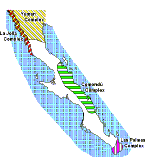Prehistoric Archaeology
 Baja California’s long prehistory is attested by innumerable shell middens lining its coasts, rock art panels hidden in mountain canyons, hunting blinds, rock quarries, burial caves, temporary camps, and village sites. Radiocarbon dates confirm that the region has been occupied since the end of the Ice Age, and more controversial claims would put the human presence still earlier.
Baja California’s long prehistory is attested by innumerable shell middens lining its coasts, rock art panels hidden in mountain canyons, hunting blinds, rock quarries, burial caves, temporary camps, and village sites. Radiocarbon dates confirm that the region has been occupied since the end of the Ice Age, and more controversial claims would put the human presence still earlier.
Pioneering archaeologists attempted to organize information about prehistory by distinguishing complexes, or groups of traits peculiar to particular spans of time and geographical regions. Many of the complexes recognized in Baja California are extensions of patterns first defined elsewhere in western North America, such as the early Holocene San Dieguito complex with its stone bifaces, scraping tools, and crescents; the middle Holocene La Jolla complex, notable for extensive shell middens and seed grinding tools; the successive Pinto and Gypsum complexes, containing distinctive large projectile point styles associated with desert adaptations; and the late prehistoric Yuman complex, with pottery and small arrowpoints. Other patterns are specific to the peninsula, including the Comondú complex of central Baja California and the Las Palmas burial complex in the Cape Region.
Rock art is undoubtedly the most studied class of archaeological evidence in Baja California. Best known are the spectacular Great Mural pictograph sites in the mountains of the central peninsula, with their larger-than-life profiles of men and women, deer, and other animals. Pictograph and petroglyph sites in a wide variety of styles are also documented from the cape to the northern frontier. Numerous studies have described these rock art panels, discussed their settings and associations, interpreted their techniques and arrangements, attempted to work out their chronologies, and speculated on their functions. The corpus of careful records has grown, but few interpretations are as yet solidly established.
Other investigators are attempting to work out the strategies for subsistence and the patterns of seasonal movements between coasts and interior characteristic of various prehistoric populations. Key issues in ongoing archaeological studies also include the question of whether aboriginal Baja Californians were very “primitive”, as early observers suggested, or had developed elaborate and successful adaptations to a uniquely challenging environment; whether their lifeways generally remained stable, or changed through prehistory; and whether various portions of the peninsula received significant influences from outside, or were essentially isolated.
In comparison with some other regions, only a limited amount of work has as yet been completed toward inventorying and interpreting Baja California’s archaeological sites. However, during recent years there has been a considerable growth in investigations by both Mexican and international researchers. For reviews of studies up to the 1980s, see García Uranga 1988 and Laylander 1992 in the Bibliography. For some of the more extensive investigations, see the reports by Harry Crosby, Barbro Dahlgren, Emma Lou Davis, Léon Diguet, Harumi Fujita, María de la Luz Gutiérrez, Enrique Hambleton, Justin R. Hyland, Ken Hedges, William C. Massey, Clement W. Meighan, Jerry Moore, Eric W. Ritter, and Donald R. Tuohy.
© 2002 Don Laylander